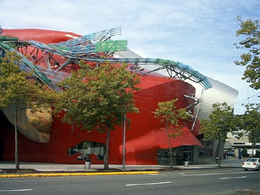On June 23, 2000, the Experience Music Project opens at Seattle Center. The museum and education center occupies a flowing polychrome pavilion designed by Frank O. Gehry and inspired by Seattle-born rock guitarist Jimi Hendrix (1942-1970). Thousands attend a weekend of special events and concerts featuring national and local artists and bands and project founder Paul Allen (1953-2018). The name will be shortened to EMP and later, following several other permutations, changed to the Museum of Pop Culture (MoPOP).
The project grew out of Microsoft co-founder Paul Allen's admiration for the music of Jimi Hendrix, the revolutionary Seattle-born rock guitarist who exploded on the international scene at the 1967 Monterey Pops Festival. As a teen, Allen attended Hendrix's triumphant hometown concert in 1968, and as an adult began amassing rock 'n' roll artifacts, including a shard of the guitar that Hendrix obliterated during his historic Monterey performance.
Allen approached the Hendrix family with his dream of a museum dedicated to the performer and he helped it reclaim lapsed copyrights to Jimi's music. In 1992, the Seattle City Council approved development of an $80 million museum at Seattle Center, but the concept soon evolved under the guidance of Allen's sister Jody Patton.
The EMP project retained architect Frank O. Gehry, famed for Barcelona's new Guggenheim art museum, in 1996. His design features an undulating ensemble of multi-colored surfaces and volumes, which some critics compared to a guitar after Jimi Hendrix was done with it. The building and its collection of 80,000 rock artifacts ultimately cost $240 million when it opened, and attracted 800,000 visitors in its first year of operation.
The project evolved over the years, and its series of names reflected that. "First it was Experience Music Project. Then it was the acronym EMP, then Experience Music Project and Science Fiction Museum and Hall of Fame ("EMPSFM" for shortish), then EMP Museum" (Kiley). Then in November 2016, it got a completely new name: MoPOP, for "Museum of Pop Culture."
According to "curatorial director Jasen Emmons ... [t]he new name 'is just catching up with who we are'" (Kiley). In the decade after adding sci-fi to its music exhibits, the museum also staged exhibitions of fine art, fashion, horror movies, and video games, and the incorporation of "pop culture" into the name reflected that trend.

